A truly intriguing article in this issue is the feature on It Came From the Desert (ICFTD), one of the most ambitious, albeit flawed, TurboGrafx-CD games ever released. ICFTD was an FMV game, conceived and birthed at the height of FMV Mania. It was an integral part of NEC's big push for FMV titles (however, since TG-16 and TG-CD were struggling, this "big push" amounted to a mere 2-3 games). Contemporary critics are quick to mock the FMV fad—and often, they are right to do so. However, despite its mediocre mini-games and campy FMV sequences, TG-CD's It Came From the Desert is greater than the sum of its parts…
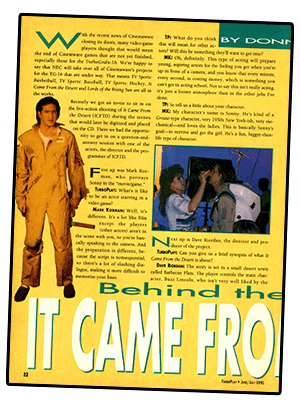
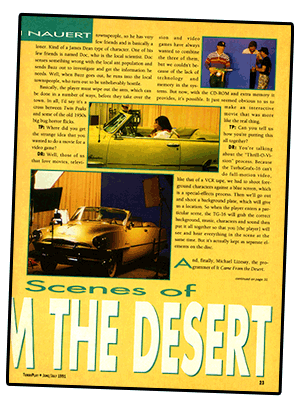

BEHIND THE SCENES: In the TurboPlay article we get to see a "sneak peak" of the actual filming of the FMV sequences. FMV was all the rage at this time, and I was unabashedly eager to see what all the hullabaloo was about.
HISTORY: Cinemaware released the orignal It Came From the Desert in 1989 for the Amiga (and shortly afterwards, for MS-DOS). A Sega Genesis port was created, too, but it was never officially released, possibly due to Cinemaware's ongoing financial problems. The Genesis version gutted nearly everything from the original game mechanics, opting instead to become an overhead shooter (an eccentric version of Ikari Warriors, if you will) with a marginal story delivered via brief, text-based dialogues. Which leaves the TG-CD version…
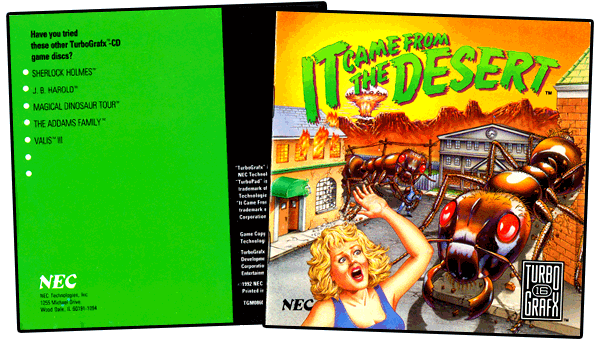
HAVE YOU TRIED THESE OTHER TG-CD GAMES? Note that the first two games listed—Sherlock Holmes Consulting Detective and the underappreciated J.B. Harold Murder Club—were part of NEC's big push for FMV titles.
SUBJECT FOR DEBATE: Of the three vastly different ICFTD games, appearing on 4+ platforms (Amiga, MS-DOS, TG-CD, Genesis), the TG-CD version offers the most enthralling story. Agree or disagree?
FMV MANIA: With FMV Mania in full-swing, the decision was made to remake (re-imagine) It Came From the Desert as an FMV (full-motion video) extravaganza for the TurboGrafx-CD. In many respects, this stayed true to Cinemaware's vision for all of its offerings (indeed, Cinemaware was always trying to blend the genres of film and video games to create an immersive experience). Thus, incorporating FMV sequences into the structure of It Came From the Desert was not necessarily an outlandish or doomed plan for revamping an existing Cinemaware title.
Why would I suggest that the TG-CD version of It Came From the Desert features the best story?
The TurboGrafx-CD story develops and unfolds in a fashion that rivals (and in some instances, improves upon) the original Amiga game. Both versions have wacky characters and bizarre situations, but the TG-CD narrative has a darker, more surreal story under the surface, making for a more compelling drama. They are both B-movie scripts, but the TG-CD version delivers moments that are more poignant: the surreal fantasy girl Buzz keeps seeing; the role of the radio DJ taking calls on-air; the omniscient and omnipresent Hive-Mind; the role of Sonny and the Professor, etc. The only performances I was unable to stomach were those of Buzz's parents.

ORIGINAL FOOTAGE vs. TG-16's FMV: For the time, and the hardware, the FMV delivered by the TG-CD was decent. If you look closely, you can see a slight blue outline around Sonny, who is superimposed on top of static image of a gas station (or is it Slug-A-Bug HQ?). All of the actors in ICFTD were shot in front of bluescreen, their performances later composited with matte backgrounds.
DAYDREAMING: If the original footage still exists, I would love to recreate the TG-CD game with upgraded video and improved mini-games.
TECHNICAL LIMITATIONS: If you have ever played the TurboGrafx-CD version of ICFTD, you'll notice how limited TG-16's FMV capabilities were, especially when compared to the original footage documented in this article (see image above). However, when you consider the constraints of the TG-16 and TG-CD hardware (an 8-bit CPU/16-bit GPU with extremely limited RAM available for CD-ROM), ICFTD is a technically impressive game that squeezed all it could from NEC's stalwart console…
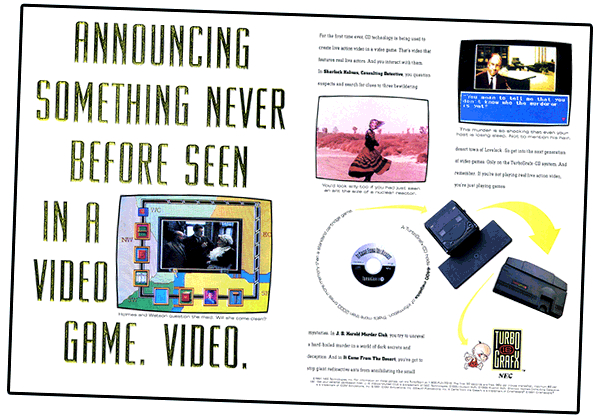
FMV ON TG-CD: This advertisement celebrates Sherlock Holmes: Consulting Detective, It Came From the Desert and J.B. Harold Murder Club as cutting-edge FMV video games on TG-CD. However, J.B. Harold does not actually contain FMV sequences, opting instead for digitized stills with hours of voiced dialogue. Furthermore, the screenshot depicting ICFTD is full-screen, full-color and at a higher resolution than the TG-CD was capable of displaying. Also, that woman in the dress, and that desert scene, are not found in the actual game. NEC was not being completely honest in this ad.
A FLAWED GAME: The FMV in It Came From the Desert serves a purpose (establishing relationships with characters, developing the story, providing clues) and is actually enjoyable to experience. So, FMV is not a problem. The real problem lies in the mediocre execution of the the mini-games/action sequences—which quickly reveal themsevles to be repetitive, lackluster and, at times, frustrating. There is a lack of cohesion amongst the different parts of the game, too. As a result, the story is experienced in somewhat disjointed moments. That said, the TG-CD version of It Came From the Desert offers the best narrative. The story unfolds at a nice pace, adding layers of intrigue, absurdity, dark humor, adult situations, surrealism and dare I say "horror" to build tension. For example, even the DJ at local radio station KOOL has a part to play in the unfolding drama in the TG-CD version (he is, in many ways, one of the few cohesive elements tying together various parts of the game). The DJ+radio station is far more robust and meaningful in the TG-CD version, overshadowing the small role KBUG played in the original Amiga version.
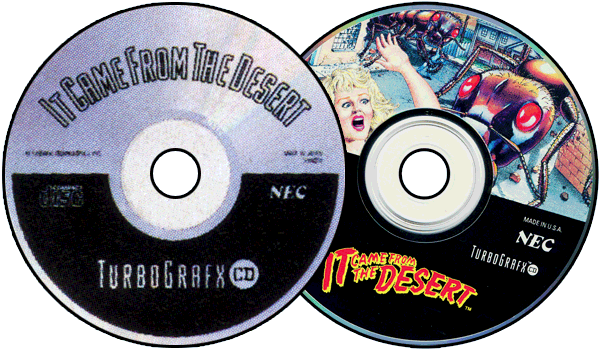
MOCK-UP vs. ACTUAL CD-ROM: If you look closely at the two-page advertisement discussed earlier on this page, you can see how TG-16's product aesthetics evolved over the years. The mock-up (on the left) represents the style found on the earliest HuCARD and CD-ROM titles—a simple, clean, layout with basic fonts and black screenprinting on the disc. It Came From the Desert experienced delays during its development. When it was finally released, TG-CD art had skipped a generation—now game art, titles and logos were printed in full color on the disc.
Of course, the Amiga version had wonderful moments that were stripped from the TG-CD storyline (our wheelchair-bound hero must escape from his hospital room, for example, in the Amiga version). The TG-CD version's only asset, really, is its more surreal, darker, occasionally-inspired narrative performed by a cast of eccentric townsfolk (the campy acting actually fits the game perfectly). I never thought I would ever say this, but, honestly, of all the FMV titles, on all the platforms (including computer as well as console), It Came From the Desert is one of the few that pulls it off semi-competently.
Continued below…
Table of Contents for TurboPlay #7▲

- 01 Cover: Bonk's Revenge (1991, HuCARD). Cover background illustration: Dale Cody.
- Believe it or not, this is the first and only time that Bonk would grace the cover of TurboPlay.
-
- 02 TurboMail: Letters from our loyal readers. 02 09
- "Rating the games, TurboBoosters, PC-Engine and SuperGrafx systems, new game developers for the TG-16 and back issues of TurboPlay…those are the subjects we deal with from the reader mailbag.
-
- 03 Table of Contents for issue #7.
- "Welcome back! There's no doubt about it—this issue of TurboPlay could be our hottest yet."
-
- 04 Advertisement: FMV on the TurboGrafx-CD. 04 05
- "Announcing something never seen in a video game. Video. And remember, if you're not playing real live action video, you're just playing games." Featured titles: It Came From the Desert, J.B. Harold's Murder Club, Sherlock Holmes: Consulting Detective."
-
- 06 Feature: PC CAVEMAN II FOR PC ENGINE - A Tale of Bonks to Come. 06 07 08
- "Bonk uses his head to show you the fun he is having. Donn Nauert takes a look at the Japanese version of what may become our own Bonk's Revenge." The proper title for the Japanese HuCARD is "PC Genjin 2".
-
- 10 Closer Look: TurboChip & TG-CD Game Reviews. 10 11
- "Check out the latest and greatest entries to the TurboGrafx-16 software library as we give you reviews of J.B. Harold: Murder Club and TaleSpin."
-
- 12 Strategy Guide: Special Edition. 12 13 14 15 16 17 18 19 20 21
- "Donn Nauert gives solutions to the tough jams that plague TurboPlay readers in: Keith Courage in Alpha Zones, Legendary Axe II, Psychosis, Valis II and Veigues Tactical Gladiator."
-
- 22 Feature: Behind the Scenes of It Came From the Desert. 22 23 31
- "Donn Nauert recently spent some time on the soundstage of what could be the most complex and technically advanced TG-16 game."
-
- 24 Games Around the World. 24 25 26 27
- "Dead Moon, Final Soldier, Side Arms Special and Ys III: Wanderers from Ys are in focus in this month's peek at Japanese games that may soon reach our shores."
-
- 28 TurboTips: Codes, Tips and Tricks. 28 29 30
- "Are your TG-16 games stinging you? Well, strike back with our expert tips on Bomberman, Chew Man Fu, Devil's Crush, Double Dungeons, Military Madness, Psychosis and Veigues Tactical Gladiator.
-
- 32 TurboPlay Contest: Previous Winners, New Crossword Puzzle Contest.
- "This month we take a different direction in choosing a winner in our contest. Sharpen your pencils and pull out your dictionaries—you're going to need them!"
▲
-
MARK KORMAN: FMV ACTOR…▲
Unfortunately, not much is known about Mr. Korman. Most likely, his career was swift and short. His most memorable role, truly, was playing Sonny in the TG-CD version of It Came from the Desert. Whether he was busy at work (Slug-A-Bug Pest Removal) or chatting on the Wristwatch TV Transceiver™ (see below), Mr. Korman's performance as Sonny was sincere…
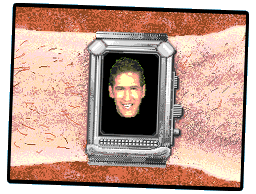

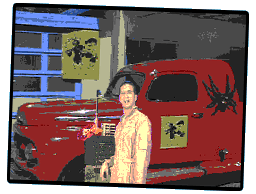
TurboPlay: "What's it like starring in a video game?"
Mark Korman: "Well, it's different. It's a lot like film except the players (other actors) aren't in the scene with you, so you're basically speaking to the camera. And the preparation is different, because the script is non-sequential, so there's a lot of slashing dialogue, making it more difficult to memorize your lines."
TurboPlay: "What do you think this will mean for other actors? Will this be something they'll want to get into?"
Mark Korman: "Oh, definitely. This type of acting will prepare young, aspiring actors for the feeling you get when you're up in front of a camera, and you know that every minute, every second, is costing money, which is something you can't get in acting school. Not to say this isn't really acting, it's just a looser atmosphere than in the other jobs I've done."
VIEW SOURCE
As anyone who has played It Came from the Desert could have surmised, Mr. Korman spent nearly all of his time in front of a blue-screen when filming the FMV sequences. The "behind-the-scenes" photographs show make-up artists and directors prepping the actor for upcoming shoots. Other photographs show the prop master holding a faux gun and giant ant appendage on set. We see grips adjusting and assembling large blue panels…clearly, a lot of time and energy was spent to produce the FMV sequences. Sadly, the digitized video in the final game pales in comparison to the raw footage that is visible on set (a video monitor shows Sonny's image crisply and cleanly composited on top of background images). What are the chances that this raw footage has survived?
Three years after appearing as Sonny in ICFTD, Mr. Korman was seen by millions of television viewers when he appeared as "Preppie" on an episode of Beverly Hills, 90210. And that, my friends, is where Mr. Korman's acting career ends. 1993. Preppie.
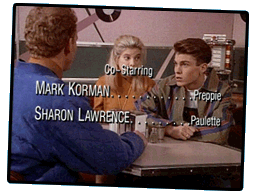




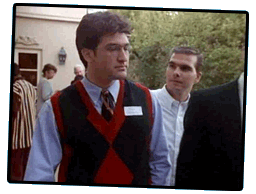

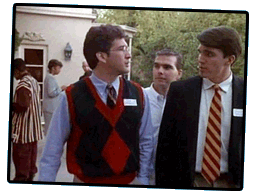
IVY LEAGUE: The character Andrea runs into an old friend and a "Preppie" at a Yale luncheon in this episode of Beverly Hills, 90210 entitled "Parental Guidance Recommended" (original air date 02.03.1993).
TRIVIA: Brian Austin Green is wearing a TV Transceiver Wristwatch™ in this episode of Beverly Hills, 90210.
INCONCLUSIVE: It is possible, though difficult to confirm, that our Mr. Korman has yet one more film credit to his name—a bit part in a short film. A "Mark Korman" is credited as playing "Janitor #3" in 1992's From the Office.
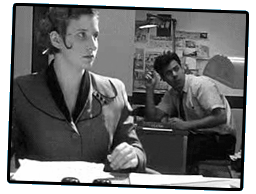
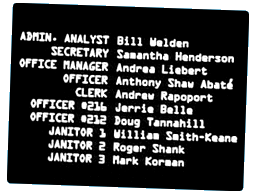
Remarkably, you can view this film at EA Media's site (under the category "film"). Even more remarkably, there are no janitors in this film. Apparently, the scene(s) featuring Mr. Korman were left on the cutting room floor.
Without a single frame of evidence, it would be foolish to attribute this credit to our beloved Mr. Korman.
THAT'S A WRAP: Needless to say, I would love the opportunity to interview anyone involved in the production of ICFTD for TG-CD. Whatever happened to our Sonny? That's the question…
▲
ICFTD: A TECHNICAL FEAT…▲
Back in the day, FMV was often discussed as if it were a virtue unto itself (not unlike contemporary discussions of polygon counts, transparency effects, etc.). These discussions quickly lost sight of the most important issue: is the game enjoyable to play? To quote from a future review of ICFTD (see TurboPlay #10, December 1991/January 1992):
"On the graphic side, this is as close to the cutting edge of technology as you can get: full-motion video running at ten frames a second, no pausing or hesitation in speech or action and very little interruption between scenes. The game consists of one full hour of video, 180 video sequences and 50 background plates."
VIEW SOURCE 1 2
As is evident, this reviewer (Donn Nauert) gushes all over ICFTD's technical attributes. He goes on to praise the title song (which does, indeed, kick ass) and points out that, in total, there are 500 voice-over tracks and a 20-song Red Book Audio soundtrack. Notwithstanding these impressive technical feats, it is my duty to inform you that ICFTD for the TG-CD is a hugely flawed game (in particular, and ironically, the action-oriented mini-games strike me as unpolished demos with horrid controls). That said, ICFTD certainly deserves some love for attempting to do FMV on very limited hardware.
TurboPlay: "Do you think this will be the wave of the future, and that we will be seeing more games done like this?"
Michael Lizesay (Programmer for ICFTD): "Definitely. It's a hot new wave, and this is the start of it all. I don't think game players will want to go back to the old arcade style of game once they have played games that use real actors, real backgrounds and more dramatic effects that can be found in CD-ROM games."
VIEW SOURCE
Truly prophetic words from Mr. Lizesay. While we may snicker now, we have to keep in mind that the folks behind these FMV games truly thought they were innovating the video game industry. And so, in an oddly twisted way, the TG-CD version of ICFTD deserves some love for trying something different and not simply re-hashing the original game. In an older version of this article, I stated that I would have preferred "a more straightforward port of the Amiga version" to appear on TG-CD. I no longer feel this way. I now fully appreciate the FMV fiasco we ended up with. The TG-CD version is truly unique, since it was one of those rare instances when a company totally revamped an existing game to convert it to an FMV game. Also, I should point out that not everyone despised (and/or mocked) this TG-CD title.
It turns out that ICFTD has always had a small cadre of fans in the Turbo community. Bless them. It took me over a decade, but I finally joined them. Disclosure: I absolutely cherish Sea of Love, the title song from ICFTD. It kicks my ass.
▲
DAVE RIORDAN & CINEMAWARE'S DEMISE…▲
ICFTD might have been a vastly better game if it weren't for its troubled development history, which was directly related to Cinemaware's ongoing financial troubles. Dave Riordan —the fellow who spearheaded the original computer incarnations of ICFTD—was overseeing the TG-CD game development, so I have little reason to suspect that his talent was lacking. Rather, I believe that budget and time constraints severely compromised Riordan's original vision. When Donn Nauert interviewed Mr. Riordan, Cinemaware was on the verge of bankruptcy. By the time the article was printed, the once mighty Cinemaware had ceased to exist:
"With the recent news of Cinemaware closing its doors, many video-game players thought that would mean the end of Cinemaware games that are not yet finished, especially those for the TurboGrafx-16. We're happy to say that NEC will take over all of Cinemaware's projects for the TG-16 that are under way. That means TV SPORTS Basketball, TV SPORTS Baseball, TV SPORTS Hockey, It Came From the Desert and Lords of the Rising Sun are all in the works."
VIEW SOURCE
Cinemaware's demise abruptly left ICFTD and several TV SPORTS titles in a lurch. NEC North America decided to finish these stalled projects (by contracting out the work to another developer, perhaps?). Who knows how this final batch of games would have turned out had Cinemaware remained solvent.
▲
BONK TO STAR IN SEQUEL, NEC SLASHES PRICES…▲
After all these years, I still remember reading the preview of PC Genjin II (Bonk's Revenge) in this issue. The game had yet to be finished, but I couldn't wait. I drooled over the screenshots. This was rather funny because I wasn't the biggest fan of the Bonk series, but the dearth of platformers in the TG-16 library ensured that PC Genjin II would be a highly anticipated title. Don't get me wrong, I love Bonk, but I always wished that the games had more depth and were more challenging. Still, the sequel promised to be a blast, so I was stoked.
If you were curious as to how expensive TG-16 hardware was during the summer of 1991, you'll be interested in this blurb that was thrown into the table of contents at the last moment:
NEWS FLASH!
As TurboPlay was being completed, we received word that the prices for parts of the TG-16 line were being dropped. The basic system will now be priced at $99.99; a Bonk SuperSet (the TG-16 system, two TurboPads, a TurboTap and a copy of Bonk's Adventure) will go for $149.99; and the cost of the TurboGrafx-CD will drop to $299. We'll have more on the breaking story next issue of TurboPlay.
VIEW SOURCE
…and sure enough, the next issue of TurboPlay had a page devoted to this price drop. Not that it warranted an entire page, mind you, since everything you needed to know had been sufficiently relayed in the blurb above. These prices would steadily decline over the next year, with the TG-16 console dropping to $69.99 and the TG-CD settling at $149.99 prior to TTi's launch for the DUO.
▲
BEHIND THE SCENES @tg-16.com…▲
This site is a labor of love and hate. I hate a lot of the tripe I write and would love to revise a lot of it. Also, I am an atrociously slow writer. But I do love the fleeting moments when I write something original. It just takes a long, long time. Apparently, my work habits are (a) incredibly predictable and (b) painfully slow. Every Sunday morning, for example, I work on this website. I've been doing this for over a decade. However, it took me five and a half years to add screenshots from Beverly Hills, 90210 to this page. Five and a half years. I honestly forgot I even had screenshots to add to the entry about Mark Korman. In fact, as I was typing the prior sentence, I remembered that I have screenshots of TTi's Intelligent Link prototype cable to add to the site. Those screenshots are nearly a decade old, at this point. Damn. I really am that slow. And I really am that predictable. Sunday morning, 5:00 AM onwards, I steal a few moments to work on this site.
Return to top of page…